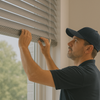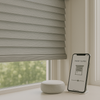Industry Trends: The Future of Smart Blinds and Automated Window Treatments
- by Mariam Labadze
Quick Answer
The smart blinds industry is rapidly evolving toward seamless integration, AI-driven automation, and sustainability by 2025-2030. Key trends include voice-activated control becoming standard rather than premium features, solar-powered motors eliminating battery maintenance, AI learning routines and automatically adjusting for optimal comfort and energy efficiency, and Matter protocol enabling universal compatibility across smart home platforms. Prices are dropping 30-40% as technology matures, making automation accessible to mainstream markets. Future innovations include transparent solar panel blinds generating electricity, health-monitoring sensors tracking sleep and air quality, and predictive systems adjusting before weather changes occur. The convergence of affordability, reliability, and genuine lifestyle benefits positions automated window treatments as standard features in new construction within five years.
Current State of Smart Blind Technology
Voice Control Integration – Amazon Alexa, Google Assistant, and Apple HomeKit integration has evolved from novelty to expectation. Current systems respond reliably to voice commands—"Alexa, close the bedroom blinds"—eliminating physical interaction entirely. This hands-free control particularly benefits accessibility, allowing elderly residents and those with mobility limitations managing windows effortlessly.
Multi-room control through single commands—"close all downstairs blinds"—provides convenience impossible with manual operation. This whole-home coordination proves valuable during departure routines, security scenarios, or weather events requiring rapid response across multiple windows simultaneously.
Smartphone App Control – Dedicated apps provide granular control over individual blinds, room groupings, or entire homes from anywhere globally. Forgot closing blinds when leaving for holiday? Adjust remotely via smartphone, maintaining security appearances and protecting furnishings from sun damage despite being thousands of miles away.
Scheduling capabilities allow programming complex routines—different opening times for weekdays versus weekends, seasonal adjustments, vacation modes creating occupied appearances. These automated behaviors optimize comfort and efficiency without requiring daily manual intervention or remembering complicated schedules.
Basic Automation – Current systems offer time-based automation (open at 7am, close at sunset) and simple sensor responses (close when temperature exceeds 28°C). These foundational automations deliver meaningful convenience and energy savings, representing smart blind capabilities' first generation that future innovations will build upon significantly.
Emerging Technologies Reshaping the Industry
AI and Machine Learning – Next-generation systems will learn household patterns and preferences, automatically adjusting without explicit programming. AI algorithms recognize that you typically close living room blinds around 7pm on sunny days, then automatically implement this behavior while adapting to seasonal daylight changes without manual schedule updates.
Predictive adjustments based on weather forecasts represent advanced AI applications—closing blinds before expected heatwaves, opening them maximizing passive solar heating before cold fronts, or securing against approaching storms. This proactive automation exceeds reactive systems responding only after conditions change.
Solar Power Integration – Battery-powered motors currently dominate cordless installations, but solar panels integrated into headrails or mounted discretely near windows will eliminate battery concerns entirely. Photovoltaic technology advances now enable small panels generating sufficient power for motor operation, making maintenance-free automated blinds genuinely achievable.
Some manufacturers are developing transparent solar panel blinds that generate electricity whilst providing window coverage—revolutionary technology potentially offsetting home energy consumption through windows that actively produce power rather than merely reducing heat loss.
Matter Protocol Standardization – The Matter smart home standard promises universal compatibility, eliminating current fragmentation where different brands require separate apps and don't communicate across platforms. Matter-certified smart blinds will work seamlessly with any compatible smart home system, simplifying installation and improving reliability through standardized communication protocols.
This standardization accelerates adoption by reducing consumer confusion and compatibility concerns that currently inhibit mainstream smart home investment. Universal standards create confidence that purchases will remain relevant and compatible regardless of future smart home evolution.
Health and Wellness Integration
Circadian Rhythm Optimization – Future systems will coordinate with sleep tracking devices and health apps, automatically adjusting light exposure supporting healthy circadian rhythms. Blinds might gradually open before wake times simulating natural sunrise, or close evenings at optimal times for your specific sleep schedule promoting melatonin production.
Integration with wearable fitness trackers allows personalizing automation based on actual sleep patterns rather than generic schedules. If your smartwatch detects poor sleep quality, blinds might adjust morning opening providing gentler wake support rather than bright immediate illumination.
Air Quality Monitoring – Sensors detecting indoor air quality could trigger automated window and blind adjustments facilitating natural ventilation when outdoor air quality proves superior to indoor conditions. This integration supports healthier home environments through intelligent fresh air management.
Combined with HVAC systems, smart blinds contribute to comprehensive environmental management maintaining optimal temperature, humidity, and air quality simultaneously through coordinated automated responses that manual operation cannot match.
Energy Management and Sustainability
Grid Integration – Smart blinds communicating with utility companies could adjust during peak demand periods, reducing cooling/heating loads when electricity costs spike or grid stress reaches critical levels. This demand-response participation supports grid stability whilst lowering consumer energy costs through automated load shifting.
Some regions are developing programs where homeowners receive incentives for allowing utility companies remotely adjusting smart home devices including blinds during emergencies. This symbiotic relationship between utilities and smart homes benefits all participants through improved grid resilience and consumer savings.
Renewable Energy Optimization – Homes with solar panels benefit from smart blinds maximizing passive solar heating during winter whilst minimizing cooling loads in summer, optimizing self-consumption of generated electricity. Coordinated systems ensure home energy use aligns with solar production patterns, reducing grid dependence and maximizing renewable investment returns.
Carbon Footprint Tracking – Future apps might quantify energy savings and carbon emission reductions from automated blind usage, gamifying efficiency and providing tangible feedback about environmental impact. This transparency appeals to eco-conscious consumers wanting measurable proof their investments deliver promised sustainability benefits.
Affordability and Market Democratization
Price Reductions – Smart blind costs have dropped dramatically—systems costing £400-£600 per window in 2020 now available for £200-£350, with continued reductions expected as manufacturing scales and competition intensifies. This democratization transforms smart blinds from luxury features into accessible mainstream products.
Entry-level systems from established manufacturers now rival premium options from just five years ago in functionality whilst costing fraction of historical prices. This value improvement accelerates adoption across broader demographics beyond early adopters and luxury markets.
DIY-Friendly Installation – Manufacturers increasingly design systems for homeowner installation rather than requiring professional integration specialists. Battery-powered motors with simple bracket mounting eliminate electrical work, whilst intuitive apps guide setup without technical expertise. This accessibility removes installation cost barriers whilst empowering consumers managing their own smart home ecosystems.
Retrofit Solutions – Add-on motors converting existing manual blinds into smart versions offer economical upgrade paths without complete replacement. These retrofit solutions appeal to homeowners with quality blinds wanting automation benefits without discarding functional treatments for entirely new smart versions.
Privacy and Security Considerations
Data Protection – As smart blinds collect usage data for optimization, privacy concerns emerge around who accesses this information and how it's utilized. Leading manufacturers implement robust encryption, local processing rather than cloud dependence, and transparent data policies addressing legitimate privacy concerns.
Future regulations will likely mandate data protection standards ensuring smart home devices including automated blinds cannot become surveillance tools or data harvesting mechanisms exploiting consumers for commercial benefit beyond agreed product functionality.
Cybersecurity – Internet-connected devices present hacking vulnerabilities that manufacturers must address through regular security updates, strong authentication, and vulnerability testing. The inconvenience of hacked blinds pales compared to other smart home security breaches, but comprehensive cybersecurity remains essential maintaining consumer trust.
Industry-wide security standards emerging through Matter and similar initiatives should improve overall smart home cybersecurity, benefiting automated window treatments alongside other connected devices through coordinated rather than piecemeal security approaches.
Commercial and Residential Convergence
Technologies developed for commercial buildings are rapidly migrating to residential applications. Office buildings have employed automated blinds for decades managing energy costs across large glazed facades. This proven technology now reaches homes at residential price points with simplified interfaces suited to consumer rather than facilities management contexts.
Large-scale implementation experience in commercial settings provides reliability data and optimization strategies that residential manufacturers leverage, accelerating smart blind maturity through learning from established commercial applications.
Integration with Broader Smart Home Ecosystems
Scene Creation – Smart blinds participate in complex scenes coordinating multiple devices—"Movie Mode" might close blinds, dim lights, and activate entertainment systems simultaneously through single commands. This coordination transforms isolated smart devices into cohesive intelligent environments responding to activities rather than requiring managing individual components separately.
Geofencing Automation – Systems detecting when you leave home could automatically close blinds for security and climate control, then reopen upon return ensuring bright, welcoming environments without manual intervention. This location-aware automation eliminates the "did I close the blinds?" uncertainty whilst optimizing comfort and efficiency automatically.
Occupancy Sensing – Future systems might detect room occupancy, adjusting blinds in unoccupied spaces for energy efficiency whilst maintaining preferred settings in active rooms. This granular automation maximizes savings without sacrificing comfort in spaces you're actually using.
The Path Forward
Smart blind adoption will accelerate dramatically over coming 5-10 years as costs decrease, reliability improves, and benefits become undeniable. New construction will increasingly include automated window treatments as standard features rather than luxury upgrades, much as central heating and double-glazing evolved from luxuries to expectations.
The convergence of genuine lifestyle benefits, environmental advantages, and improving affordability positions automated blinds crossing the chasm from early adopter enthusiasm to mainstream acceptance. This transition transforms window treatment industry fundamentally, requiring manufacturers adapting to technology-integrated future or risking irrelevance.
At 1 Click Blinds, we're committed to making smart blind technology accessible and understandable for UK homeowners. As the industry evolves, we'll continue offering cutting-edge automated solutions alongside traditional options, ensuring everyone finds window treatments matching their needs, budgets, and comfort with technology.







